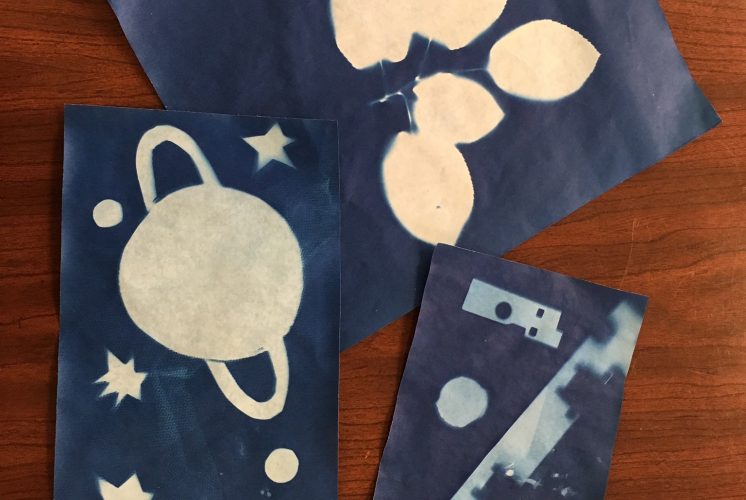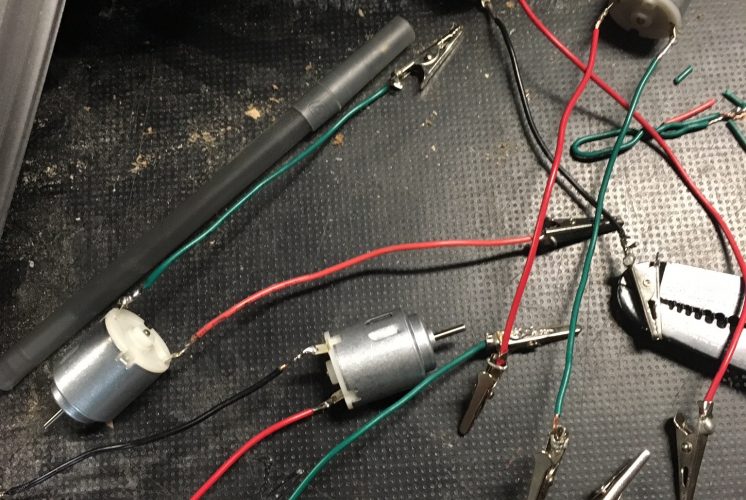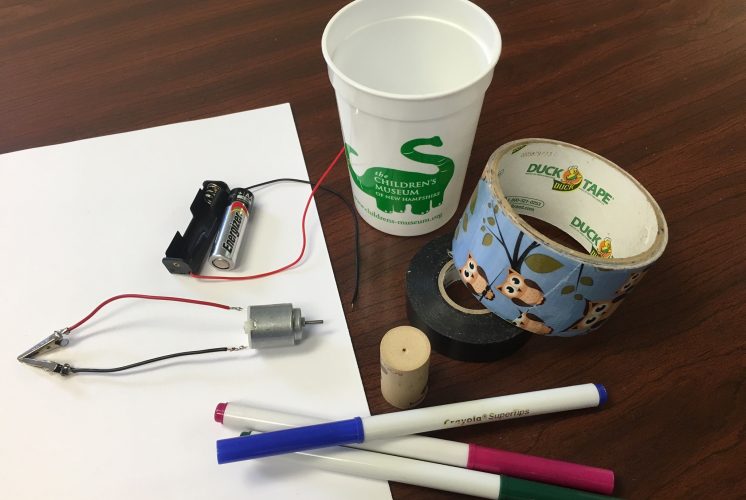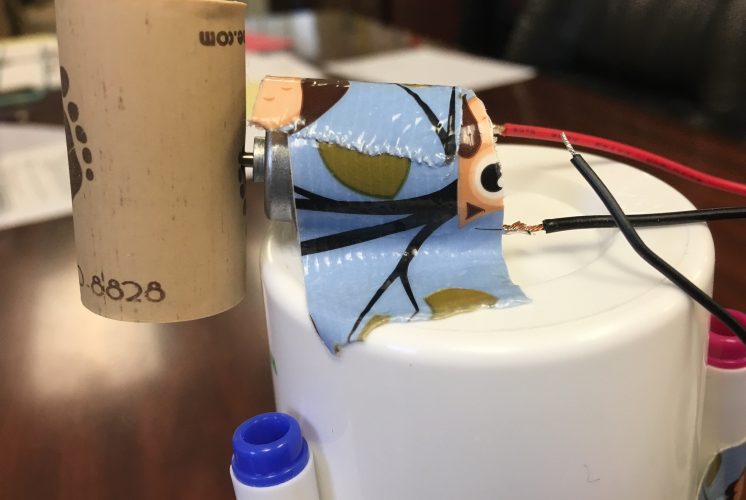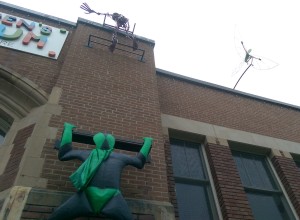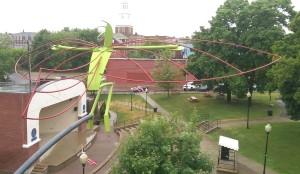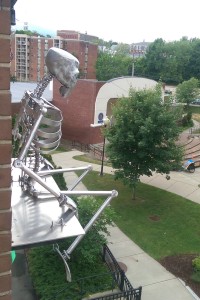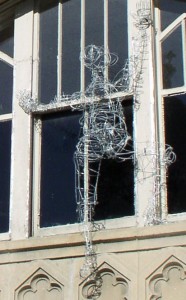The Museum Blog
Category: Maker Movement
NH’s only Maker Faire will be held in Dover

The fourth annual Dover Mini Maker Faire, taking place on Saturday, August 27, 2016 and organized by the Children’s Museum of New Hampshire, is New Hampshire’s only licensed Maker Faire. But, what exactly is a Maker Faire? “It’s a question we get asked a lot,” laughs Children’s Museum of New Hampshire President Jane Bard. “It’s a hands-on festival for all ages. Faire-goers get to see what the creative and innovative people and businesses (also known as Makers) in their communities are making and creating, and the Makers who choose to participate in the Faire get to show off their knowledge! And all of our Makers offers a unique activity or workshop for people to try out.”
The Dover Mini Maker Faire is designed to be forward-looking, showcasing makers who are exploring new forms and new technologies. But it doesn’t just highlight the technical fields. Maker Faires, in general, also feature innovation and experimentation across the spectrum of science, engineering, art, performance and craft. So it’s not unlikely to see a young baker showcasing her cupcake recipes next to a high-tech personal transportation device from Segway at a Faire…both of which you can see at this year’s Dover Mini Maker Faire.
At the Dover Mini Maker Faire, which takes place inside the Children’s Museum of New Hampshire, outside in Henry Law Park and across the river at One Washington Mills, people can make and launch a paper rocket, find out how to publish a book, learn about beekeeping, drive a robot, learn how to code, eat ice cream made using liquid nitrogen, take a selfie with a Stormtrooper, explore electricity and make a working circuit, try their hand at movie stunt fights, learn about the science of brewing and so much more. “People really are amazed at just how much there is to do at the Faire,” said Jane. “In fact, I think we figured out that to see everything at the Faire you’d have to spend only 6 minutes at each Maker booth!”
This year’s Faire has the most Makers signed up to participate, as well as the most food vendors, since it started four years ago. “We’re pretty excited about all the Makers of course,” said Jane “But I’m also looking forward to trying food from all our food trucks!” Newcomers to the Faire, Boogalows Island BBQ, Vagabond Coffee, Sub Zero Ice Cream and People’s Popcorn will join alumni Terra Cotta Pasta, Kona Ice and 7th Settlement Brewery’s “Juice Burger” truck. In the spirit of the Maker Movement, many of these food vendors are “Do-It-Yourselfers.” “Sub Zero Ice Cream will be doing an on stage science experiment with nitrogen, 7th Settlement Brewery will be giving tours of their micro brewery which is right across the street from the museum, and Vagabond Coffee made much of their setup at Port City Makerspace…who is also represented at this year’s Faire” said Jane.
2016 marks the 4th annual Dover Mini Maker Faire. The Faire is a licensed event through Maker Media. The first Maker Faire was hosted in the Bay Area of California in 2006 as a place for makers to show what they made and share what they learned. In 2013, 100 independently-produced Mini (one day events) and Featured (2 or more day events) occurred around the World. In fact, this year’s Dover Mini Maker Faire is scheduled on the weekend between Calgary, Canada and Berlin, Germany Faires.
Volunteers are still needed to help with this year’s Dover Mini Maker Faire. Volunteers who sign up for at least one 3-hour shift will receive free admission to the Faire. All volunteers must be 16 years or older.
Tickets to the Dover Mini Maker Faire are on sale now for $10. Tickets will cost $12 at the door and kids ages 5 and under are free. Purchase tickets, learn more or sign up to volunteer at www.makerfairedover.com.
The Dover Mini Maker Faire is sponsored by the Unique College Savings Plan by Fidelity, VELCRO® Brand, Alexander Technology Group, Prime Buchholz, Beswick Engineering, The Rowley Agency, Construction Services of New Hampshire, Albany Engineered Composites, Chinburg Properties, Holy Rosary Credit Union, Garrison Women’s Health, Coed Sportswear, Inc. and Leone, McDonnell & Roberts, PA. Media sponsorships have been provided by iHeart Media, 95.3 The Bull, Z107, NH1 News on WBIN TV and New Hampshire Public Television.
Calling All Makers 2016
4th Annual Dover Mini Maker Faire Seeks Participants

The Dover Mini Maker Faire, New Hampshire’s only licensed Maker Faire, takes place in downtown Dover every year at the end of August and is hosted and organized by the Children’s Museum of New Hampshire. Saturday, August 27 is a day-long festival where people of all ages show what they are making, and share what they are learning. But it’s not your typical New England fair. More than 1,600 people attended last year to interact with robots, play with rockets, try their hands at science experiments, geek-out with innovative technology, create arts and crafts and so much more.
The Children’s Museum of New Hampshire is seeking Makers to participate in this year’s Faire.
“We get asked all the time, what exactly is a ‘Maker,’ and the answer is really very simple. Anyone who loves to create things with their own hands is a Maker!”
“Makers are everywhere once you start looking for them,” said Neva Cole CMNH Communications Director. “Many people might not ever even consider calling themselves makers until I point it out to them. I have friends who have normal jobs, but on the weekend they make their own soap, or build portable pizza ovens that they take to the beach! Some are stay-at-home moms who are incredible artists, or stay-at-home dads who build go-carts in their garage!” All ages are welcome to apply as Makers at the Dover Mini Maker Faire. Applications are online at www.makerfairedover.com. The deadline for Makers to apply is Friday, August 5.
The Dover Mini Maker Faire is not your typical “Ferris wheel and cotton candy” fair, although there will be incredible local food from Terra Cotta Pasta, 7th Settlement Brewery, Boogalows BBQ, Kona Ice and Clyde’s Cupcakes. This is a hands-on festival for all ages, and in the tradition of Maker Faires, celebrates the thriving resourcefulness, innovation, creativity and forward-thinking technology that can be found in New Hampshire today.
“We continue to be so impressed by the region’s creativity, and feel honored to be able to provide these makers, whether they are young or young at heart, with a venue to showcase their talents,” said Jane Bard, President of the Children’s Museum of New Hampshire.
The Dover Mini Maker Faire will take over downtown Dover, with four locations: upper and lower Henry Law Park, The Children’s Museum of New Hampshire, and One Washington Mill.
Advance tickets will be on sale July 1-31 for $10 and tickets at the gate will be $12. Children ages 5 and under are admitted free. Tickets can be purchased online at www.makerfairedover.com.
For more information on the Dover Mini Maker Faire, please call 603-742-2002 or visit www.makerfairedover.com.
Here Comes the Sun
By Sarah Terry
Well, I am thrilled to report that the first session of our inaugural Maker Club at Woodman Park Elementary went wonderfully! It was so much fun, the kids are a blast to work with, and by the end of the hour, we had ten working Artbots bumping their ways around the room! One of our second grade students told her teacher afterwards, “You know, I never thought I would ever make a robot... and then I did!”
We had three-legged ArtBots, four-legged ArtBots, double ArtBots, BotBots (bots without marker legs, of course!), and more! It was quite the buzzy creative party!
And there's only one way for a Maker Club to celebrate this success... by making more stuff!
 Our next hands-on project involves one of my favorite ways to combine art and science – photography! I'm probably on the edge of the last generation that remembers using film cameras. I was just getting old enough to learn how to load the film myself when digital cameras became popular and quickly took hold of the market. Digital cameras are fascinating in their own right and have made photography more accessible than ever, but my mother is a photographer and I'll always have a soft spot for film... and the chemistry you can learn by understanding how it works!
Our next hands-on project involves one of my favorite ways to combine art and science – photography! I'm probably on the edge of the last generation that remembers using film cameras. I was just getting old enough to learn how to load the film myself when digital cameras became popular and quickly took hold of the market. Digital cameras are fascinating in their own right and have made photography more accessible than ever, but my mother is a photographer and I'll always have a soft spot for film... and the chemistry you can learn by understanding how it works!
There are many types of film that use different chemicals to capture different colors of light, but we're going to be working with cyanotypes!
Cyanotypes, sometimes called sun prints, were invented in 1842 by Sir John Herschel. Does that name sound familiar? Herschel's father William is the man who discovered Uranus! John Herschel continued his father's work in astronomy – he named seven of the moons of Saturn, and four moons of Uranus – but he also made large contributions to the field of photography.
Cyanotypes were originally used to reproduce notes and diagrams (their bright color is where we get the term blueprint from!). The first person to use the process to make photographs was Anna Atkins, an English botanist and friend of John Herschel. She is considered by some to be the first female photographer! She used the process to document different kinds of algae and seaweed, and published a book called (fittingly), Photographs of British Algae: Cyanotype Impressions. Technically, what Atkins created were photograms. Photograms are made by contact printing – she put pieces of algae directly on the paper and exposed it to create her images!
We're going to be making some photograms of our own today!
Now, I bought already-treated cyanotype paper film, but you can actually make the film yourself! This process involves chemicals, so you'd want to make sure you have goggles, gloves, a mask and a well-ventilated area to work in! This article documents the process, and the supplies you'd need.
Materials:
- Sunprint paper
- Supplies to make your image. Now this could be all kinds of materials – I cut designs out of paper, and used some mesh, but you can use leaves, shells, Legos, anything you think has a cool outline!
- Plexiglass sheet
- Plastic bin
- Vinegar (or lemon juice!)
- Water
Now cyanotypes are made through a chemical reaction with UV or ultraviolet light! The chemicals in the paper – ammonium iron (iii) citrate and potassium ferricyanide – react with UV light to create an insoluble blue dye! Then you develop the film in water and a little vinegar, and your print is finished!
To begin, make sure that you are in a room where sunlight can't reach you! You don't want any UV light to touch your print before you're ready. Luckily, indoor lights aren't powerful enough to produce ultraviolet light, so you don't need to work in a darkroom, like you would for ordinary film.
Get the complete step-by-step instructions here in a handy dandy printable PDF
Check out this video to see the process in action!
Makers Gonna Make
by Sarah Terry
First things first...
Hi there!
As this is my first blog post for the museum, I thought I'd start with a quick introduction! My name is Sarah, and I'm an educator at CMNH. I've been working here for about three years, and I've done everything from putting on a production of “The Little Red Echidna” (an adaptation of “The Little Red Hen,” of course!) to talking everyone's ears off (children, parents, and staff alike) about NASA's New Horizons mission on Pluto Day! I'm a poet, sci-fi nerd, enthusiastic baker, and can bust out soprano arias in four different languages if asked (I have never been asked...).
I'm also a maker.
But... what exactly is a maker? The museum hosts the Dover Mini Maker Faire, there are makerspaces popping up all around - it's a maker revolution! But what does it mean? Even when I first started hearing that word thrown around, it was obvious that it was about more than just people making stuff (although people making stuff is super cool all by itself!). The Maker movement has taken on its own philosophy – it's about learning, creativity, DIY, technology, curiosity... Want to know how a computer works? Take it apart and look! Want to create a beautiful piece of jewelry? Grab some wire and beads and experiment! But I think perhaps the most important part of the maker movement is this: All these cool things you want to try...you don't have to do them in a vacuum.
The maker movement emphasizes learning through doing, but it also encourages social interaction.
It encourages getting together and figuring something out with your friends, and finding a makerspace where you can learn from experts, or passionate amateurs, or somebody who tried the same thing last week! It's about sharing knowledge, and sparking curiosity – nurturing our innate and insatiable desire for the how and why behind everything.
It's with that philosophy in mind that I started working on CMNH's newest traveling program – our MAKER CLUB! Beginning this fall, we're bringing 4-week sets of after-school activities to schools in the area that focus on all different kinds of creations and the science behind making them. I've been having such an awesome time creating the curriculum that I wanted to share some of the projects we're going to be working on!
Session One of Maker Club is all about electricity!
We'll be playing with circuits and lights and fans and motors, and learning about how electricity moves through them all. We'll also be creating these nifty guys:
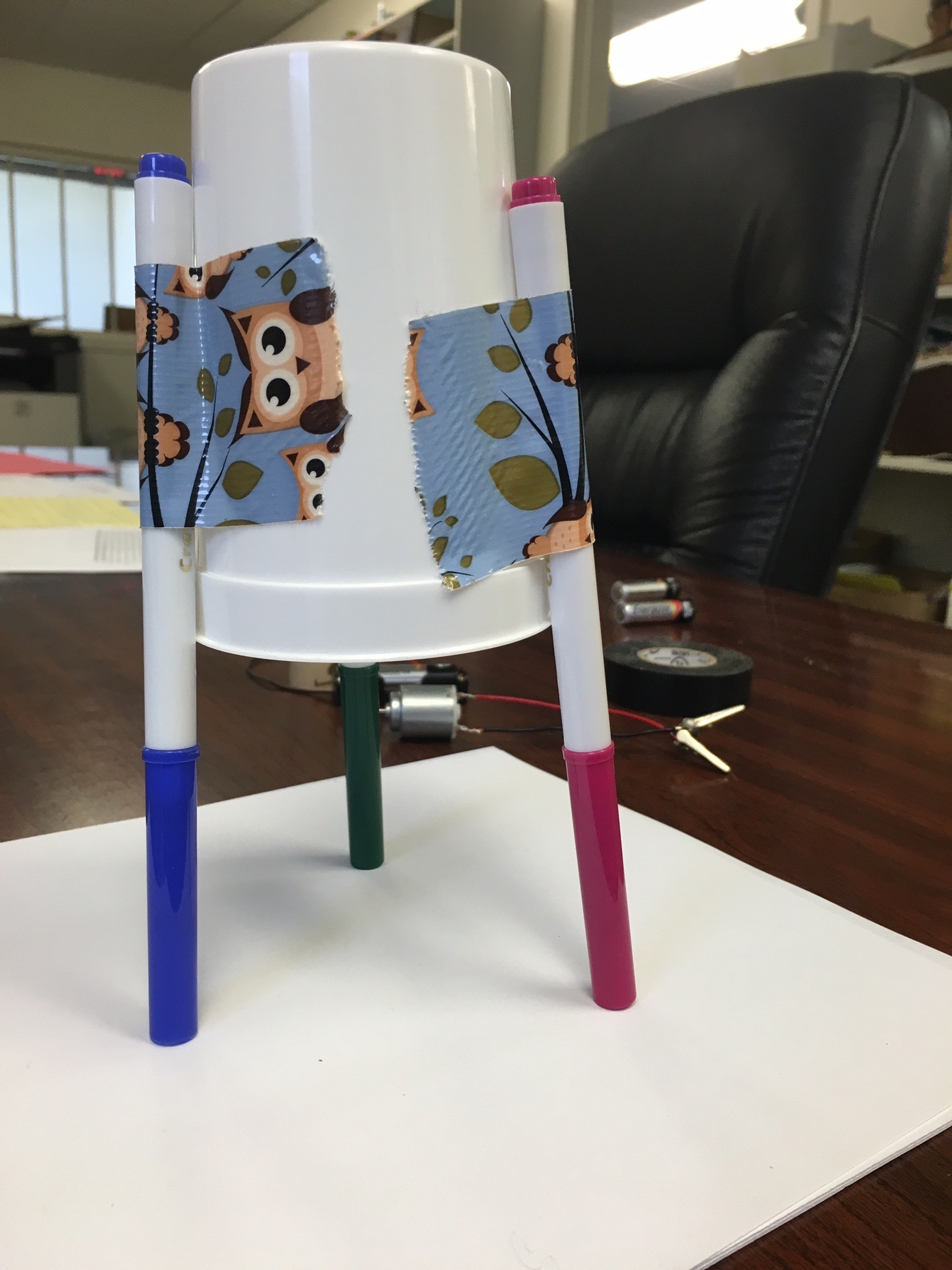
This is an ArtBot! It only takes a few simple parts to make one – there are even kits available online that have everything included. But if you want the option to customize all your parts and experiment with different techniques, you might want to buy the pieces separately.
Here's everything I used to make the ArtBot pictured here:

Materials:
- Plastic cup
- Duct tape
- Electrical tape
- Three markers
- Cork
- AA battery
- AA battery holder (optional)
- 1.5 – 3V mini motor
- Thin insulated wire with alligator clips
- Lots of paper!
Now, I went through an extra step before I got started and soldered lead wires onto the motor itself, but you can also just get wires with clips and clip them right onto the motor. But I really wanted to learn how to solder! It's neat!
Get the complete step-by-step instructions here in a handy dandy printable PDF.
Wow! Look at that ArtBot go!
Now how can you change the movement of your ArtBot? The ArtBot moves because the spinning cork puts it slightly off-balance and starts to shake it around. You can see in some of the video that I added aluminum foil to the cork to change the balance. How else can you change the balance? Could you add more markers? Move the battery or the motor? Check it out for yourself!
Bonus pictures of soldering!

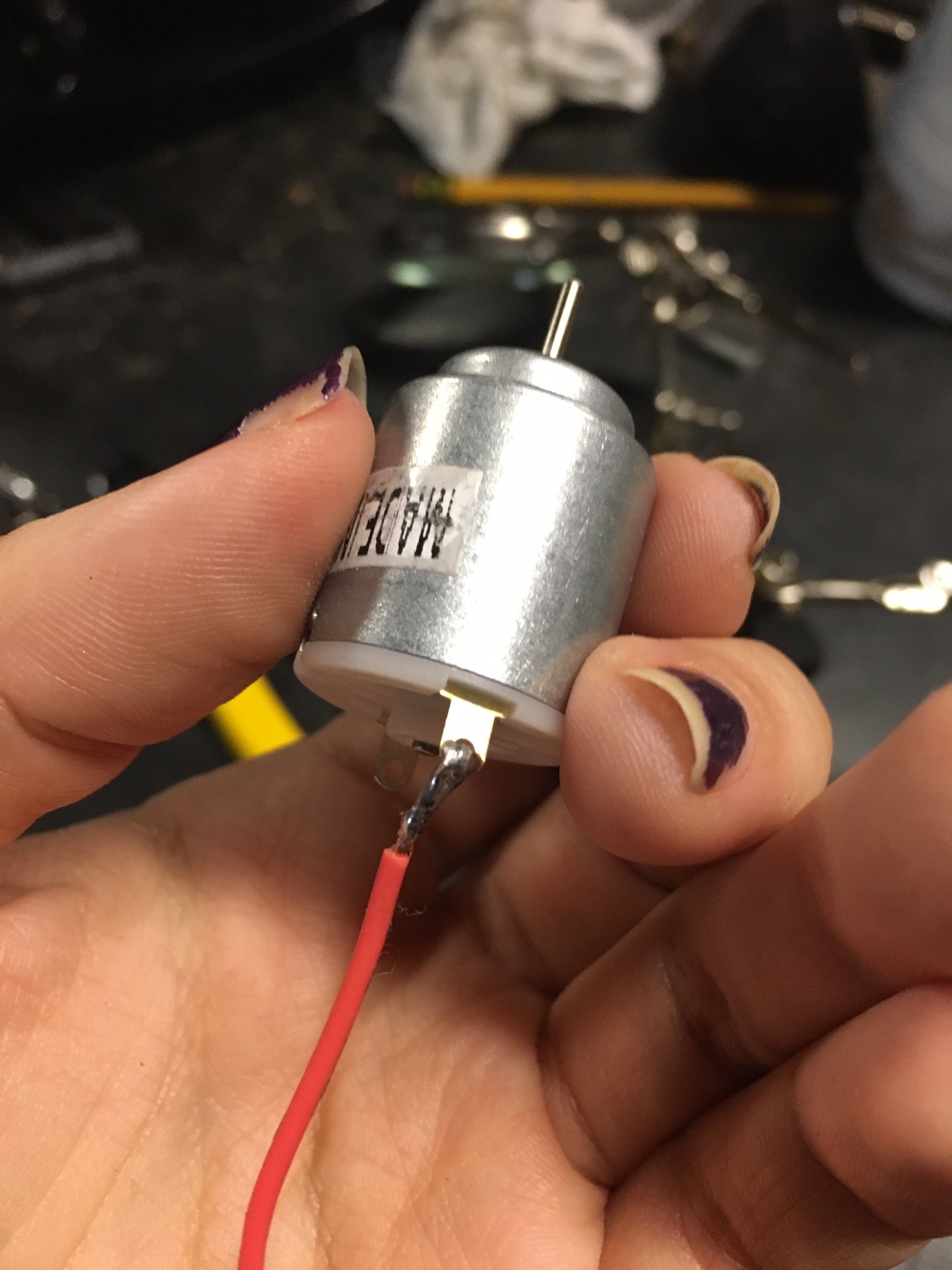 Soldering is the process of joining together two or more metal items by melting and flowing a filler metal (called solder) between them! It involves high temperatures and molten metal, but it is actually pretty easy to do (at least to do poorly – my joints work but aren't exactly pretty!). Consider buying a soldering iron, and trying it out for yourself. There are a ton of instructions online, or you could check out a local maker group like Port City Makerspace in Portsmouth, NH, and see what resources they have available!
Soldering is the process of joining together two or more metal items by melting and flowing a filler metal (called solder) between them! It involves high temperatures and molten metal, but it is actually pretty easy to do (at least to do poorly – my joints work but aren't exactly pretty!). Consider buying a soldering iron, and trying it out for yourself. There are a ton of instructions online, or you could check out a local maker group like Port City Makerspace in Portsmouth, NH, and see what resources they have available!
Want to learn a little more about electricity? Check out this information sheet from our Maker Club!
Maker Faire FAQs
"What exactly is a 'Maker Faire'?"
We hear that question a lot when we are out and about, talking up our Dover Mini Maker Faire, coming up on Saturday, August 29. It's a deceptively hard question to answer! I usually say things like "It's a place where people who make things, engineer things, craft things, etc. can come together and show off their creativity."
"...So, there aren't any rides?"
Well, no. There aren't any rides. But we think it's just as fun. So to clear up some of the confusion about what visitors to a Maker Faire can expect, here's a handy list of frequently asked questions and our answers.
Q. What exactly is a Maker Faire?
A. Maker Faire is family-friendly festival of innovation, creativity and resourcefulness, and a celebration of the Maker movement. Part science fair, part county fair, and part something entirely new. Maker Faire is an all-ages gathering of tech enthusiasts, crafters, educators, tinkerers, hobbyists, engineers, science clubs, authors, artists, students and commercial exhibitors. All of these “makers” come to Maker Faire to show what they have made and share what they have learned.
Q. How did Maker Faire get started?
A. The Maker movement sparked at the first Maker Faire back in 2006 in the Bay Area. Since then, sponsorship of Maker Faire events from corporations has helped propelled this grassroots movement eastward like wildfire. The original Maker Faire event was held in San Mateo, CA and in 2012 celebrated its seventh annual show with some 800 makers and 110,000 people in attendance. World Maker Faire New York, the other flagship event, has grown in three years to 500+ makers and 55,000 attendees. Detroit, Kansas City, Newcastle (UK), and Tokyo are the home of “featured” Maker Faires (200+ makers).
Q. Why is it called Dover MINI Maker Faire?
A. Across the United States and the world, community-driven, independently organized Mini Maker Faires are now being produced. Dover Mini Maker Faire is independently organized and operated under license from Maker Media, Inc., and is the FIRST Mini Maker Faire in the state of New Hampshire.
Q. Are there rides?
A. No. There aren't any rides like you would see at a regular town fair. BUT, there are a ton of hands on activities and opportunities to explore new things. In addition to all the great Maker tables and demos, we'll be offering an opportunity to help us build a giant Jenga and there will be a grand finale involving coke and mentos "explosions!"
Q. So what exactly will I see at the Faire?
A. You will see lots of tables and booths outside in Henry Law Park with people displaying and demonstrating their creative talents. If you want to learn more about the individual vendors, we've compiled a great list of them over on our makerfairedover.com blog!
Q. How many people can I expect to see there?
A. The first year (2013) we had more than 1,200 people attend (300 of which were kids)!
Q. What does it cost?
A. If you buy tickets online before August 29, tickets cost $10 for anyone over 5 years of age. Kids ages 5 and younger get in for free. You can buy tickets at the door for $12.
Q. Is that all the money I'll spend while at the Faire?
A. If you are just looking around at all the great inventors and trying your hand at the different activities, then yes, that's all you'll spend. There are, however a few vendors who are selling their wares, and of course food will cost you extra. We will also have t-shirts for sale for a reasonable price. But your admission will get you into all areas of the Faire, including the Children's Museum.
Q. I'm a CMNH member. Do I get into the Faire for free?
A. Look for an email from us in early August with a Member discount code.
Q. Will there be food?
A. Yes! We have quite a few vendors who will be selling food.
Q. Can I bring my dog?
A. Yes, you may bring your dog to all outside locations (i.e. Henry Law Park), however with the exception of service animals, dogs are not permitted in the Museum or in One Washington Street Mill. However, for the safety and well being of our four-legged friends, we recommend you leave your pets at home. There will be loud noises, many moveable parts, and large crowds, all of which do not create a safe environment for pets.
Q. Where exactly is the Faire?
A. The Faire takes place in and around the Children's Museum, Henry Law Park, and One Washington Street Mill, which is directly behind the Museum.
Q. Is there parking?
A. Yes! Weekend parking is free throughout the city of Dover, but we suggest:
- Henry Law Avenue in front of the museum
- the River Street lot- Drive past the museum along Washington Street, veer onto Waters Street, then cross the bridge to River Street.
- The Orchard Street lot near the Post Office (accessed via Central Avenue or Chestnut Street)
- The Amtrak lot on Chestnut & Third Streets
- The Third Street lot next to Holy Rosary Credit Union
- The Portland Street lot
- The Library lot on Locust Street (across from the Police Station)
Q. What about handicap parking?
A. There are a few handicap parking spots on Washington Street right next to the museum, as well as in the TD Bank lot across the street.
If you find yourself saying "I have a question and I don't see the answer here," then feel free to email us at [email protected] and we'll do our best to clear things up for you. We hope you can make it to Maker Faire this year!
Ascent or Descent
A Public Art Collaboration
Have you been by the Children’s Museum of New Hampshire recently? There seems to be a group of characters climbing . . . sitting . . . jumping . . . flying? Are they climbing up . . . sideways . . . down? Are they friendly or not so nice? Where did they come from and what are they doing on the front of CMNH?
Ascent or Descent is a collaborative public art project designed by the Children’s Museum of New Hampshire with six Seacoast area artists and craftspeople. This project is designed to make you curious and wonder what it is, exactly, that's happening with these figures upon our facade and what the different stories may be behind each one. We purposefully kept our description of a 'humanoid sculpture' request very broad when potential contributors were contacted. We wanted to show a diverse group of 'people' created in a variety of styles using a multitude of materials.
David Masse is a local blacksmith living on the southeastern coast of Maine who used this opportunity to design and construct something different than he would typically.
Masse decided to create a superhero and shaped it by using forged steel. He then added a fabric cape that blows in the wind. What do you think this superhero's codename is? What are his powers and how did he get them? What if he (or she!) isn't a hero . . . but a villain?!
You can check out more of David Masse's work on his website.
Rick Burns, a sculptor working based in Berwick, ME, describes his work as "creating Industrial Symbolic Abstractions using metal, wood, clay and mixed media".
If you look closely at his sculpture, you can discover some hidden objects! Do you see the wrenches that make up the arms between the elbow and the wrist?
What about the gears inside the chest? Do the gears help this character move? Does he have to be wound up like a toy? And, of course, you can't possibly miss the incredibly cool medieval helmet with pieces of chain mail. This "humanoid sculpture" is ready for anything!
You can find more creative works of art from Rick Burns at his website.
Adam Pearson is a New Hampshire based sculptor and craftsman. His child-sized figure is jumping . . . or is he flying . . . off the roof of the Children's Museum! Is this the first time he's opened up his wings and flown? Is he looking for food . . . or is he playing a game? Is he headed towards the park . . . or higher into the trees?
This sculpture, the highest piece in the installation, was created by Pearson cutting, bending and welding the metal and steel of the green body and the large red tail and swooping wingspan.
More of Adam Pearson's work can be found on his website.
Chris Wright is a local artist and Director at the Port City Makerspace. For Ascent or Descent, Wright designed and created a piece that is fashioned almost entirely from aluminum. This includes the frame, bones, ribs, head, and extremities!
Wright fabricated every piece of the sculpture, including all the individual vertebrae in the articulated spine.
There was a time not too long ago that Nate Walker's Giant Blue Crab sculpture was one of the only pieces of public art in the city of Dover. Now, Wright's piece joins five other pieces of public art looking down at art in several places in Henry Law Park!
Like Chris Wright, Jeff Gunn is also a Director at the Port City Makerspace and a local craftsman. Gunn began with aluminum to create the general form of the body for this robot . . . or is it astronaut . . . or is it robot astronaut?
He then heated and bent PVC boards to create the white outer shell around the aluminum. To design and produce the hands and other smaller parts for this piece, Gunn used some newer technology: a 3D printer!
One of the coolest features of this piece is one that can't be seen from the ground - but its effect can! On the top of right shoulder, Gunn installed a solar panel. The panel is connected to the "eye" bulb of the robot figure. So after a long day of bright sunshine, a cyclopean beam of light emerges as dusk falls. Is he guarding the museum . . . or is he guarding the park? Is he taking a picture with his eye . . . or shooting lasers?
Kali Ann Rocheleau is an artist who enjoys exploring many different mediums, including charcoal, watercolor, sculpture, and cartooning. She lives in Portsmouth with her fiancée and loves to create art whenever she can.
Rocheleau chose to make sculpture with a more whimsical, pencil-sketch like quality. She created this sculpture using bent and twisted pieces wire. One of the coolest part's of this central piece of the installation is that depending on where you're viewing it from, it seems to change shape. From one angle it appears to be a woman, but from another - a man. From the outside you can see its hands and fingers in great detail, while the feet and toes are better viewed from inside. This piece also blends in with the building almost perfectly. Is it because the figure has the ability to turn invisible? Is she made up of water . . . or is it air?
More of Kali Ann Rocheleau's art can be found on her Facebook page.
The amazing . . . or is it magical . . . or is it scientific . . . or is it fantastical figures that make up Ascent or Descent will be visiting the museum and Henry Law Park from June to the end of October 2015. For those interested in previous public art projects by the Children's Museum of New Hampshire, check out our look at Bryan Rutland's abstract art piece that adorned our building through this last winter and spring or at the journey of how artist Nate Walker and the Dover Middle School Art Club designed, created and installed the Octopus Bike Rack in front of CMNH.
- - - Begin Transmission - - -
A Strange Communication Arrived This Morning . . .
When CMNH Staff arrived to work this morning things were definitely . . . different. The exterior facade of our building and our roof had received . . . visitors . . . in the night.
Who are they? Where do they come from? What do they want?
All that was left for us was this video . . .




